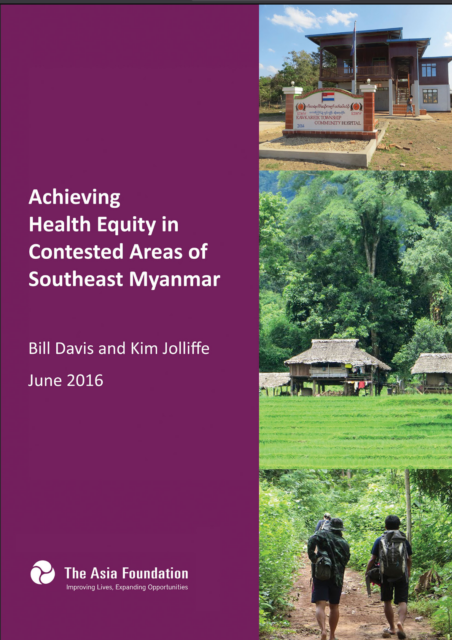Achieving Health Equity in Contested Areas of Southeast Myanmar
11 July 2016

Throughout decades of ethnic armed conflict, the governance environment in many of Myanmar’s non- Burman areas has become deeply fractured, as ethnic armed organizations (EAOs) have established parallel governance systems, including healthcare departments. This report gives an overview of the parallel Ministry of Health (MoH) and EAO-linked health systems that exist in southeast Myanmar, and looks at how coordination and cooperation have increased since ceasefires were signed in 2011 and 2012. It provides guidance and actionable recommendations for government, ethnic organizations, and international aid actors on how to strengthen service delivery and improve levels of cooperation and coordination.
Since the late 1980s, a coalition of four EAO health departments and three local health non-governmental organizations (LNGOs) in southeast Myanmar has developed to provide primary healthcare services to hundreds of thousands of the country’s hardest-to-reach and most vulnerable people. This coalition, which centers around the Mae Tao Clinic(MTC), does not have an official name, but refers to its member organizations collectively as the ethnic and community-based health organizations (ECBHOs), so this term will be used throughout this report.1 Since ceasefires were signed between the government and the major EAOs in southeast Myanmar in 2011 and 2012, considerable space has opened up for greater cooperation between the ECBHOs and the MoH. Crucial progress has been made on trust building, ensuring ECBHOs more space to operate, information sharing, and a few joint projects.
Under the government of the National League for Democracy (NLD), an unprecedented opportunity has emerged to increase cooperation. Since coming into power, the party’s National Health Network has released a Roadmap Towards Universal Health Coverage in Myanmar, which makes repeated references to ECBHOs and the need for greater engagement. Among other points, the document states, “In conflict and post-conflict areas, [ethnic health organizations] have long been providing essential services to populations that public sector providers do not reach.”2 It also recommends that “a communication and coordination mechanism with [ethnic health organizations] needs to be established,” and that the government should “encourage different levels of health administration to collaborate and coordinate with EHOs.”
Announcements
28 February 2025
Asian NGO Network on National Human Rights Institutions , CSO Working Group on Independent National Human Rights Institution (Burma/Myanmar)
Open letter: Removal of the membership of the dis-accredited Myanmar National Human Rights Commission from the Southeast Asia National Human Rights Institution Forum

Progressive Voice is a participatory rights-based policy research and advocacy organization rooted in civil society, that maintains strong networks and relationships with grassroots organizations and community-based organizations throughout Myanmar. It acts as a bridge to the international community and international policymakers by amplifying voices from the ground, and advocating for a rights-based policy narrative.
